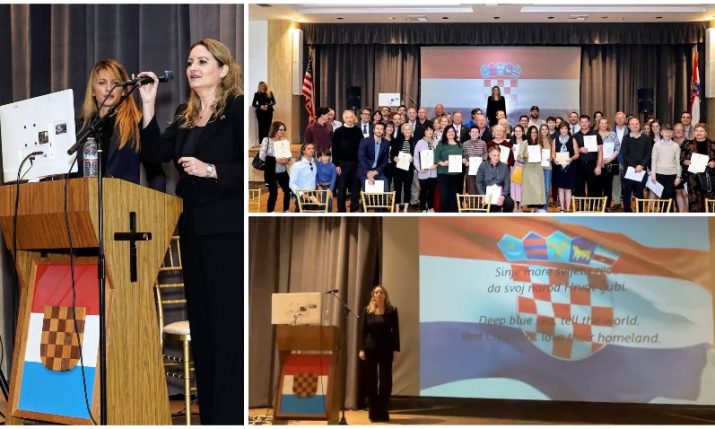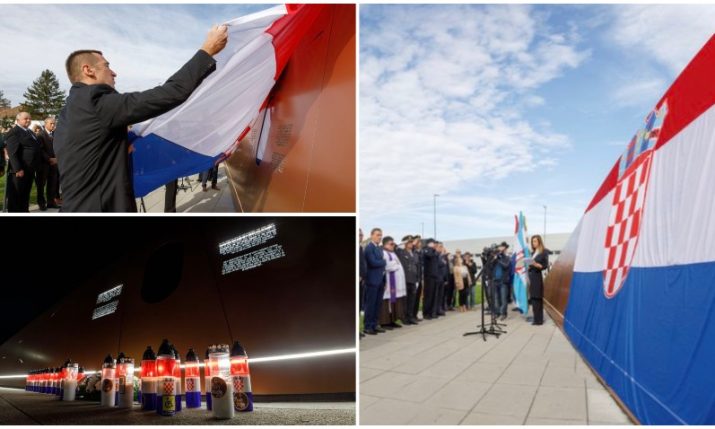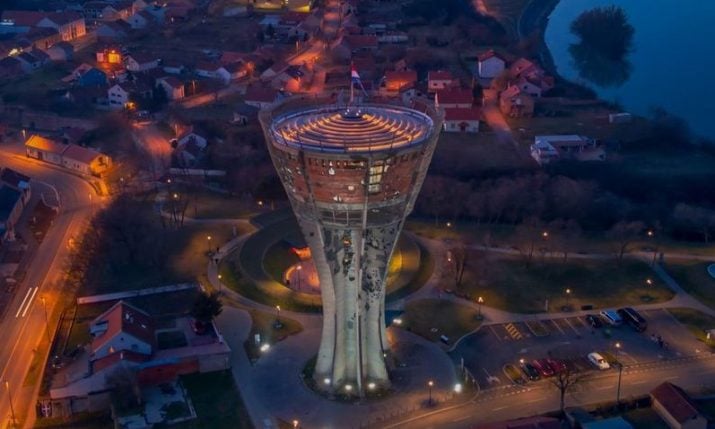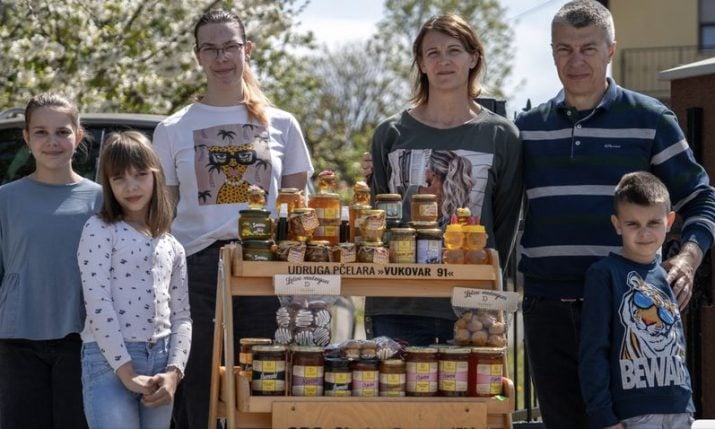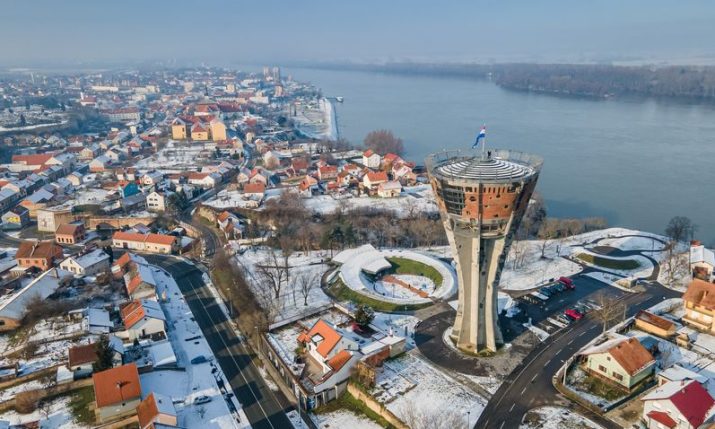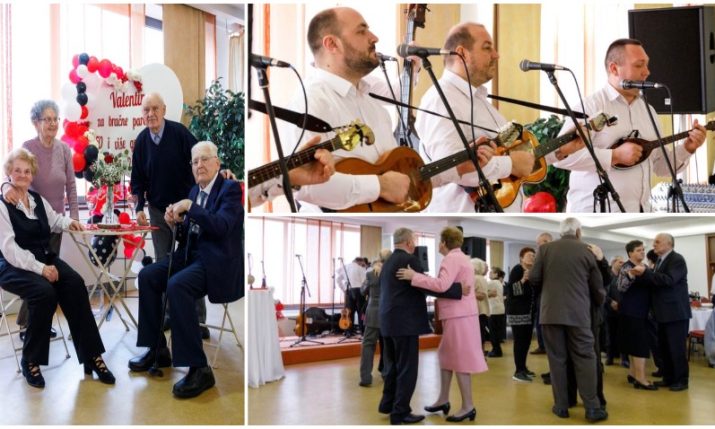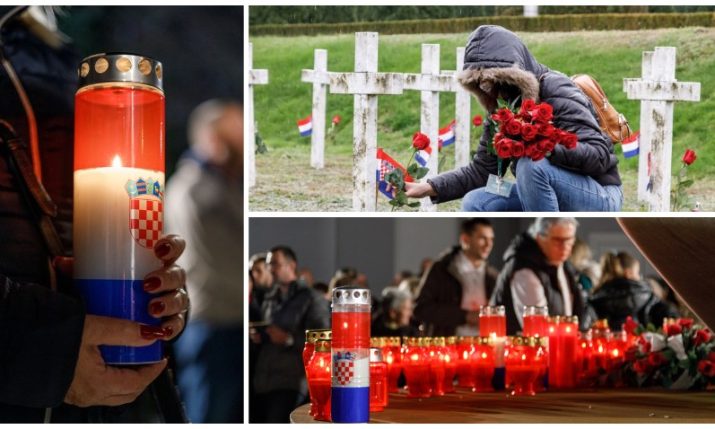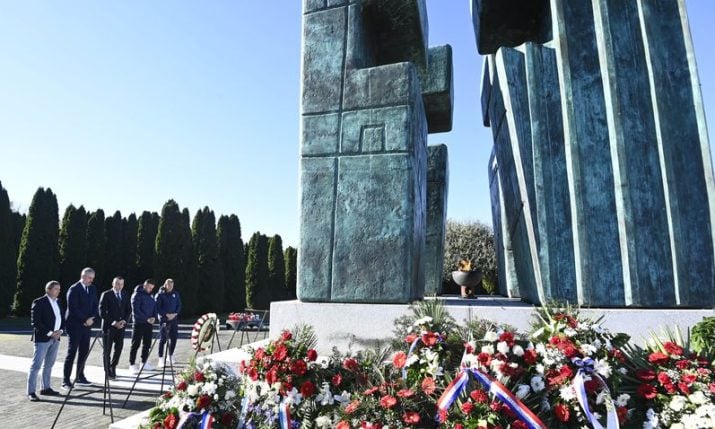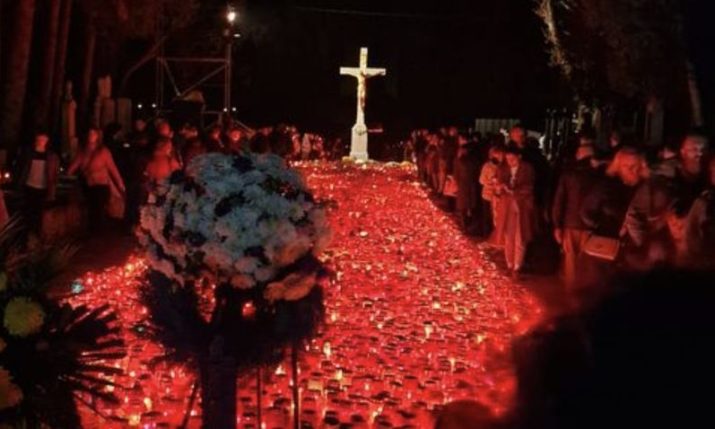Vukovar – The past, the present, the future
- by croatiaweek
- in News
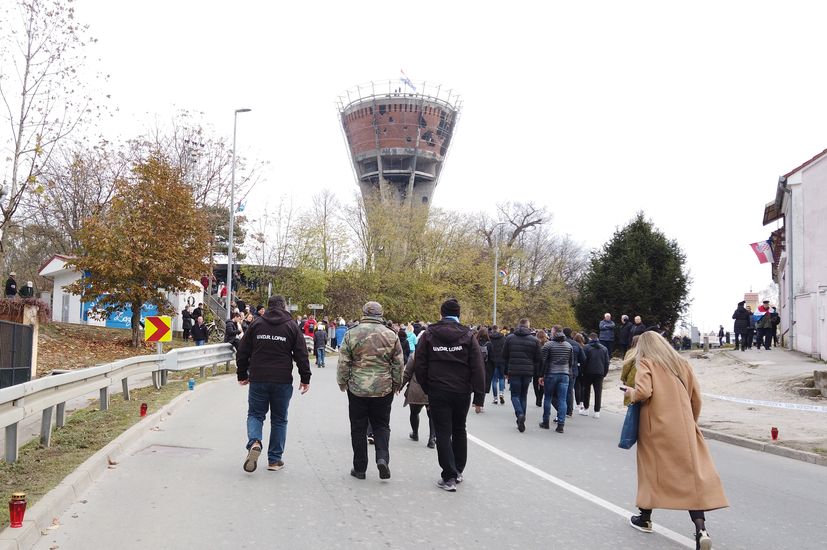
Walking in the procession towards the Vukovar Graveyard as part of yearly commemorations. Here you can see Vukovar’s most renown symbol- its water tower (Photo: Mate Paškanović Pavković)
By Mate Paškanović Pavković, Ana Katalinić
Thirty years have passed since the world witnessed the war crimes committed in Slavonia, Baranja and Western Srijem, some of the worst since the Second World War. Decades later, the Austro-Hungarian heritage buildings that were destroyed in Vukovar have been returned to their classic beauty, homes have been reconstructed, and shelling cracks and holes have been filled and painted over throughout towns and villages.
Life in Slavonia has moved on, however the spirit of the war that ravaged the people cannot be forgotten so easily. The defenders and the people of Vukovar know because of their actions from August 25th, 1991, to November 18th, 1991, garnered enough time to portray to the world what the Yugoslav National Army (JNA) and Serb paramilitary’s intentions really were. This bought time for the rest of Croatia to regroup, rethink, and plan logistical and tactical step forward.
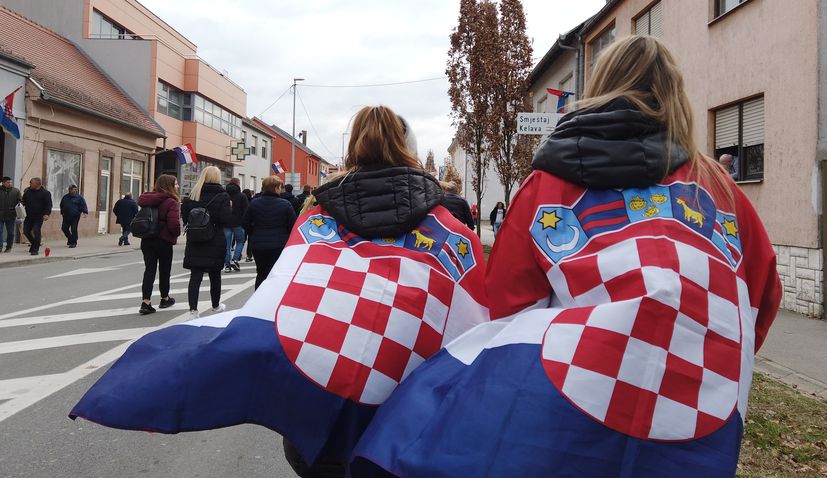
In the procession many people drape themselves in Croatian flags or flags of military units that fought in the Homeland War (Photo: Mate Paškanović Pavković)
On May 30th, 1990, the Croatian Parliament (Sabor) would convene and hold its first parliamentary elections after 44 years of being part of the Socialist Federal Republic of Yugoslavia. Preceding this fundamental event establishing democracy for Croatia’s people were many turbulent economic, political, and social events that would weaken Yugoslavia, a state destined to fail from its establishment. in 1953, 1963 and more specifically in 1974, after the 1971 Croatian spring, the highly centralized Yugoslavia slowly loosened its central grip which consequently allowed Croatia and other republics to establish a path towards independence.
In the ‘80s, after many visits to Canada and garnering the support of Croatian-Canadians and other Croatians in the diaspora, Franjo Tuđman would vie for independence. Croats abroad, after much convincing and reassurance, believed that Tuđman would be the man who would establish a free and independent Croatia. Even with their unwavering support, Tuđman would face even greater issues in Croatia.
After the 1990 Sabor election, the Croatian people would face the diplomatic and political challenge of calming the rebel Serbs in the country. One such event was in 1990 at the height of the tourism season in Croatia. Rebel Serbs blocked key routes with big logs connecting the north of Croatia with its southern cities, known as the Balvan Revolucija (Eng. the Log Revolution). Another event sparking tensions in Vukovar was on May 1st, 1990, when rebel Serbs ambushed Croatian police officers and took many of them hostage in Borovo Selo, a village north of Vukovar, an event known as the Borovo Selo Massacre.
The last straw came on October 7th when the JNA bombed the Croatian Sabor in Zagreb. On the 8th of October, in the basement of the INA Gas Company headquarters in Zagreb, Tuđman declared full independence from Yugoslavia. Through all these events, Franjo Tuđman consistently tried to negotiate with the rebel Serbs including laying out full rights and full political involvement of minorities enshrined in Article 15 of the 1991 Croatian Constitution. Article 15 as well as the law on minorities allowing for road signs in different languages if a minority populous consists of over 33% of the population, would become a contentious issue in years following the fall of Vukovar.
The Events of those 87 days
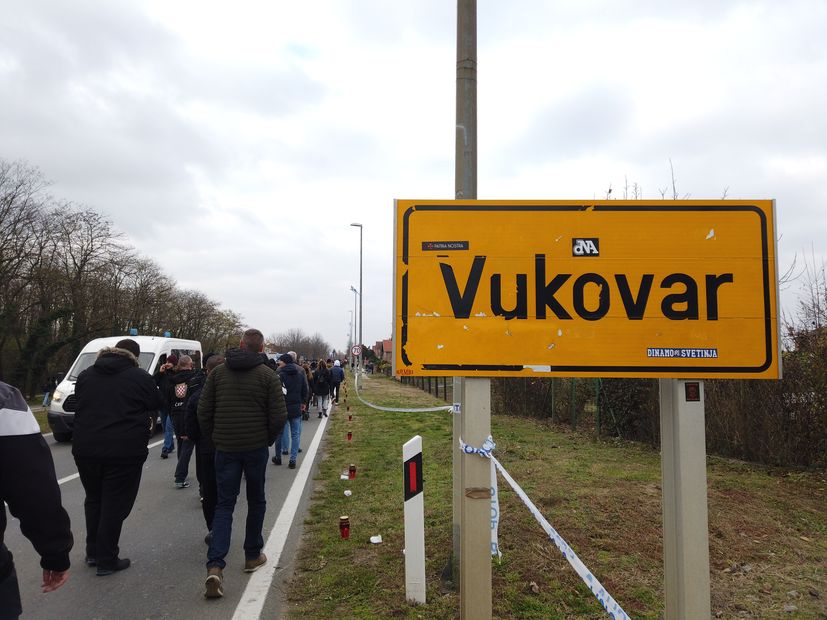
This year, despite Covid restrictions, there were over 70,000 people who walked the 3 km procession from the center of Vukovar to the Graveyard (Photo: Mate Paškanović Pavković)
The fighting in Vukovar would start on the 25th of August when JNA tanks would leave their army barracks and flex its power amongst the civilian population. On September 25th, The United Nations Security Council passed resolution 713 which placed an arms embargo on Croatia and Yugoslavia. This placed the Croatians at a huge disadvantage. Eighty-seven days of consistent bombing, shelling and air raids by the JNA, a sparsely armed Croatian corps of defenders put up an incredible fight that was logistically incomparable. The JNA was the 4th strongest Army in Europe in 1991 and was better equipped than the Vukovar Defenders who had a few cannons, hunting rifles and self-made explosives.
The end came on November 18, 1991, when the city fell, and all Vukovar’s non-Serb residents were expelled from the city. Some Vukovar Defenders escaped the city through the Kukuruzni Put (Eng. The Corn Path) that was a corridor to the nearby village of Bogdanovci. Other soldiers and male civilians were less fortunate. As would be a pattern that was repeated in Srebrenica in 1995, men and women and children were separated from one another. The women and children were sent out of the city on buses, with many women dealing with the trauma of being raped by rebel Serb soldiers, while the men were sent to concentration camps. Soldiers who were considered the leaders of the defense were liquidated immediately. In the days following, the massacre would begin. There were many moments in which the city was supposed to fall, but due to the heroic actions of the Croatian Defenders, the city stood despite imminent defeat.
Legal action, not enough
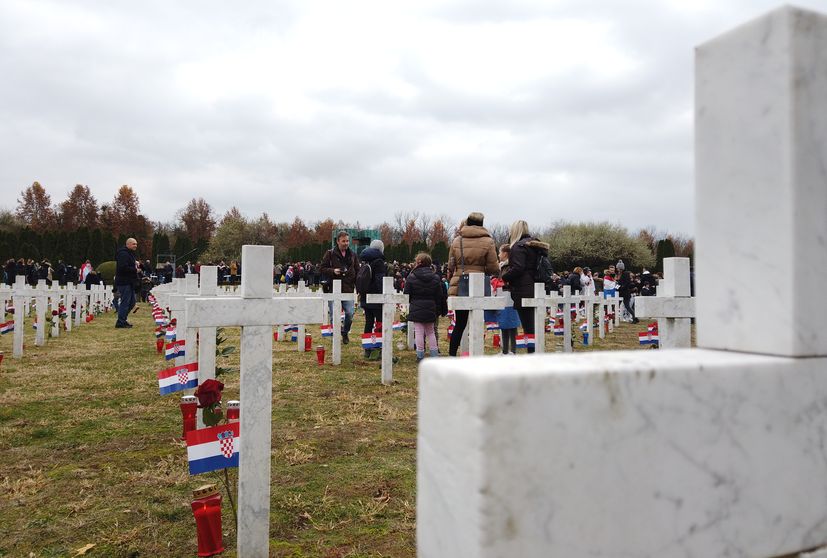
In the graveyard, there is a white cross for every soldier who died defending the city of Vukovar- including those who died in concentration camps (Photo: Mate Paškanović Pavković)
In the upcoming years, 3 JNA officers were tried at the International Criminal Tribunal for the former Yugoslavia (ICTY). Miroslav Radić was acquitted, Mile Mrkšić and Veselin Šljivančanin received lighter sentences, lighter than what many Croatians thought were deserved when you contrasted them against the crimes in question.
The tribunal zoomed in and focused in on how civilians and soldiers from the Vukovar Hospital were treated after the fall of Vukovar, rather than those who were beaten and killed in the Vukovar Massacre. Essentially, the tribunal says, leaders could not have known how vile and hateful the rampant Serb paramilitaries and territorial defense would be to the Croat prisoners and, therefore, did not take measures to adequately protect them.
The Serb territorial defense and paramilitaries were never searched for. They are there today, living side by side with their neighbors, in Vukovar, Osijek, Erdut, and Borovo Selo. The same neighbors who they attempted to kill, rape and torture. Forgiveness and reconciliation are hard when there is much injustice still felt by the victims of these horrible crimes.
After 30 Years, visiting his loved ones
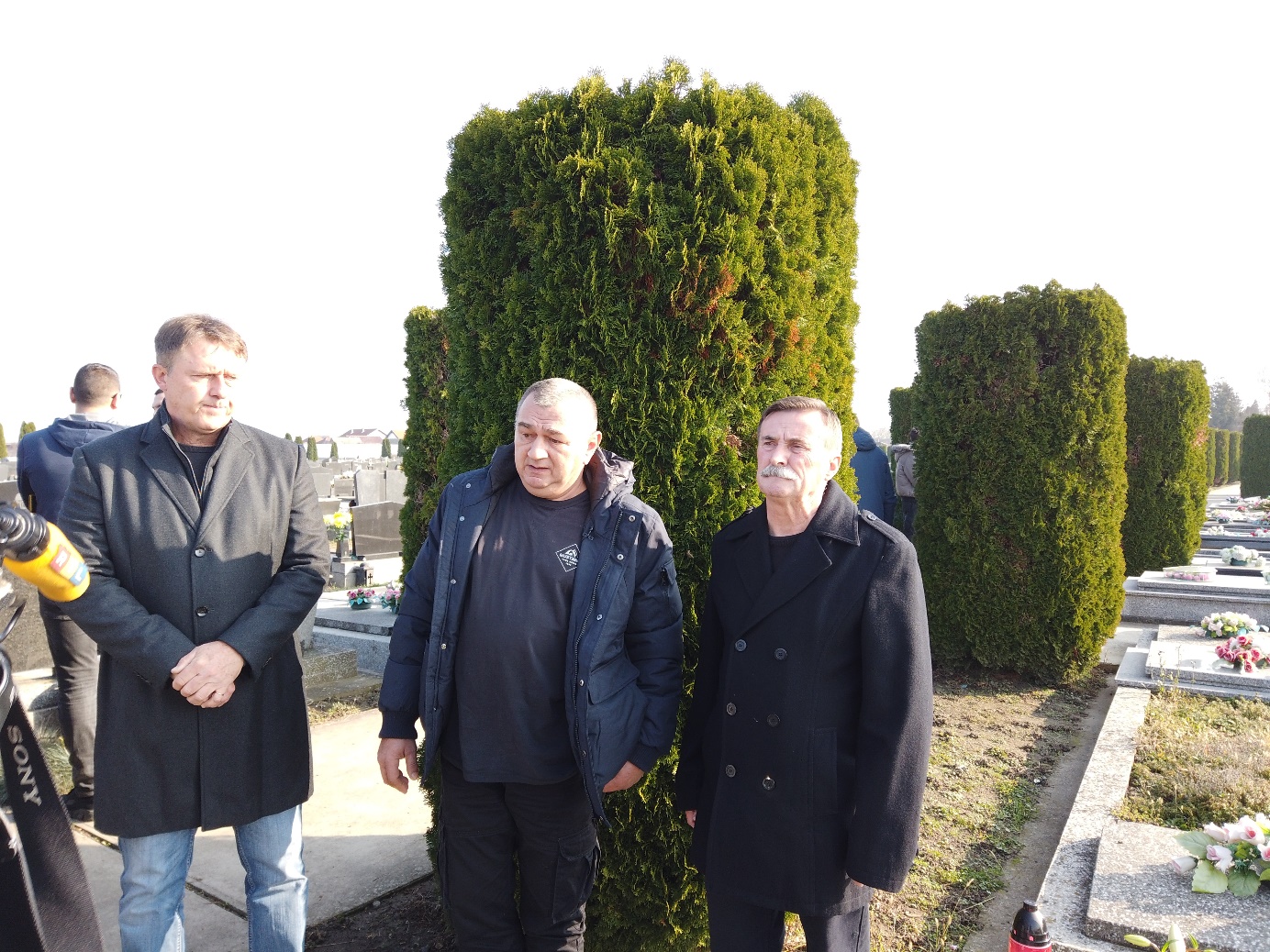
This picture shows Zdenko Štefančić (center) and Ivan Anđelić Doctor (right) at the grave of Štefančić’s family for the first time in 30 years
I had the opportunity to go with Damir Plavšić, a Croatian defender and author, to support Zdenko Štefančić whose family was liquidated from Borovo Selo while he was in a concentration camp after the fall of the city. After 30 years, and because of Ivan “Doktor” Anđelić, Vukovar defender, Štefančić finally mustered enough courage to visit the grave of his four year old daughter.
The Štefančićs were a Croatian family living in the predominantly Serbian Borovo Selo, the same village in which rebel Serbs ambushed Croatian police officers in 1991. His family was buried in the predominantly Serbian Orthodox cemetery and due to the nature of the Serbian residents- ex. there are police stationed in front of the memorial for the 12 fallen police officers in the Borovo Selo Massacre 24/7- there were riot police surrounding the cemetery.
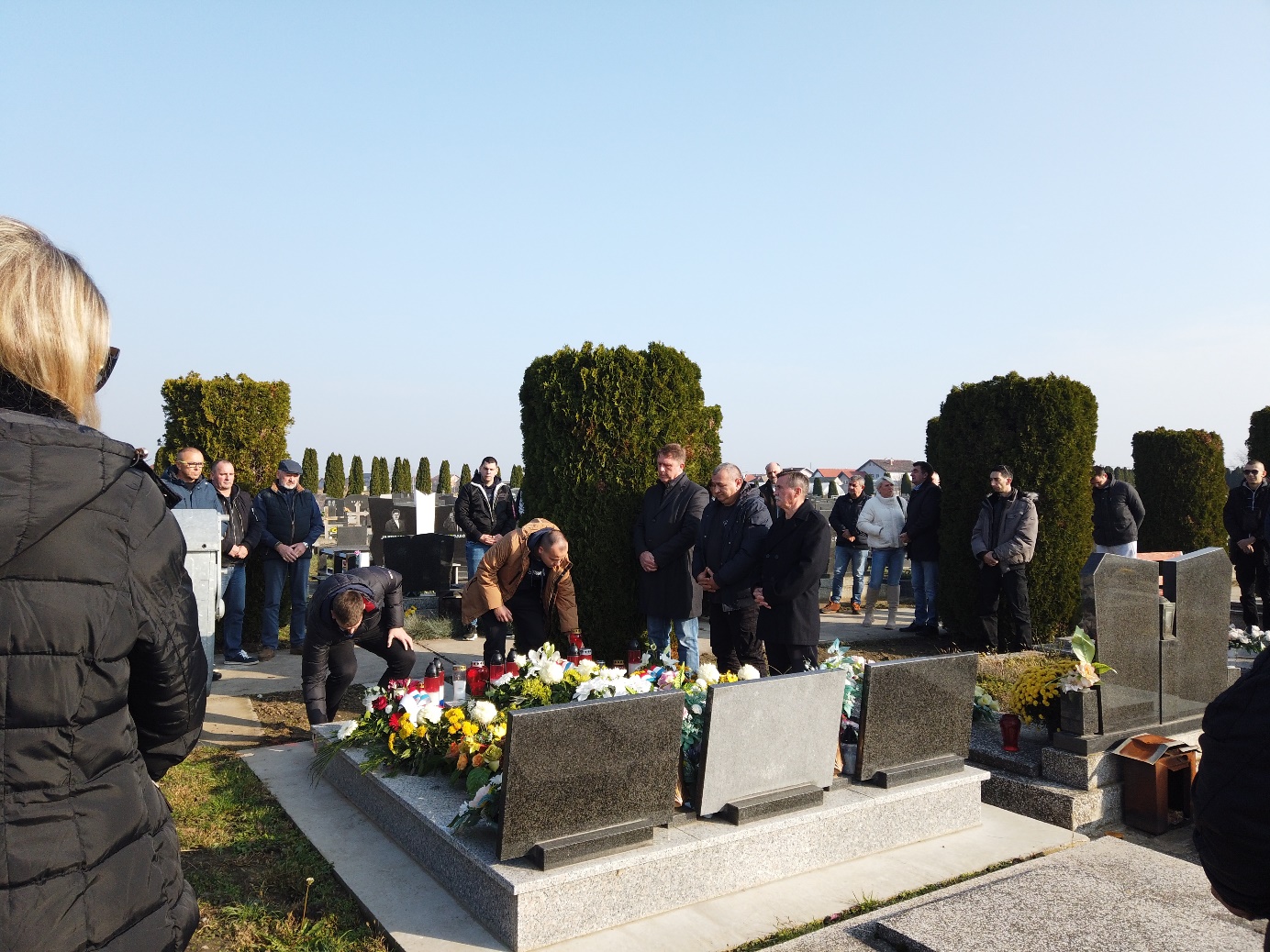
Many defenders and youth from the non-profit Djeca Odana (Eng. Loyal Children) came to place candles and flowers on the grave of Štefančić’s family (Photo: Mate Paškanović Pavković)
One thing I noticed amongst the living Vukovar defenders is that they simply have lost their emotion to all discussion about the war. They lived through events that consequently programmed them to think differently about death. Their faith in God and believing in a life after death seems to have given them grace. Despite this, it is hard to see the perpetrators of such heinous crimes still walking the streets of Vukovar. Štefančić sees the man who killed his family every day. Due to the way International criminal law functions, the International Tribunal could not conclude a Joint Criminal Enterprise between the local Serb Paramilitary’s crimes and the JNA. Additionally, the lack of will by the Croatian judiciary to prosecute the criminal acts in Vukovar leaves many without the justice they need to move forward.
Zdenko Štefančić was one of the lucky ones. To this day there are still around 1,800 people missing. After the fall of Vukovar, grave crimes against humanity happened where the town’s non-Serb residents were tortured, killed, and their bodies dumped in mass graves in undisclosed locations around Vukovar and Northern Serbia. One such example was the Ovčara farm, which was found by Tadeusz Mazowiecki, Special Rapporteur of Human Rights in the Territory of the Former Yugoslavia. 200 bodies were exhumed in 1996 but due to the condition of their bodies it took an even longer time to identify them.
The International Volunteer Defenders
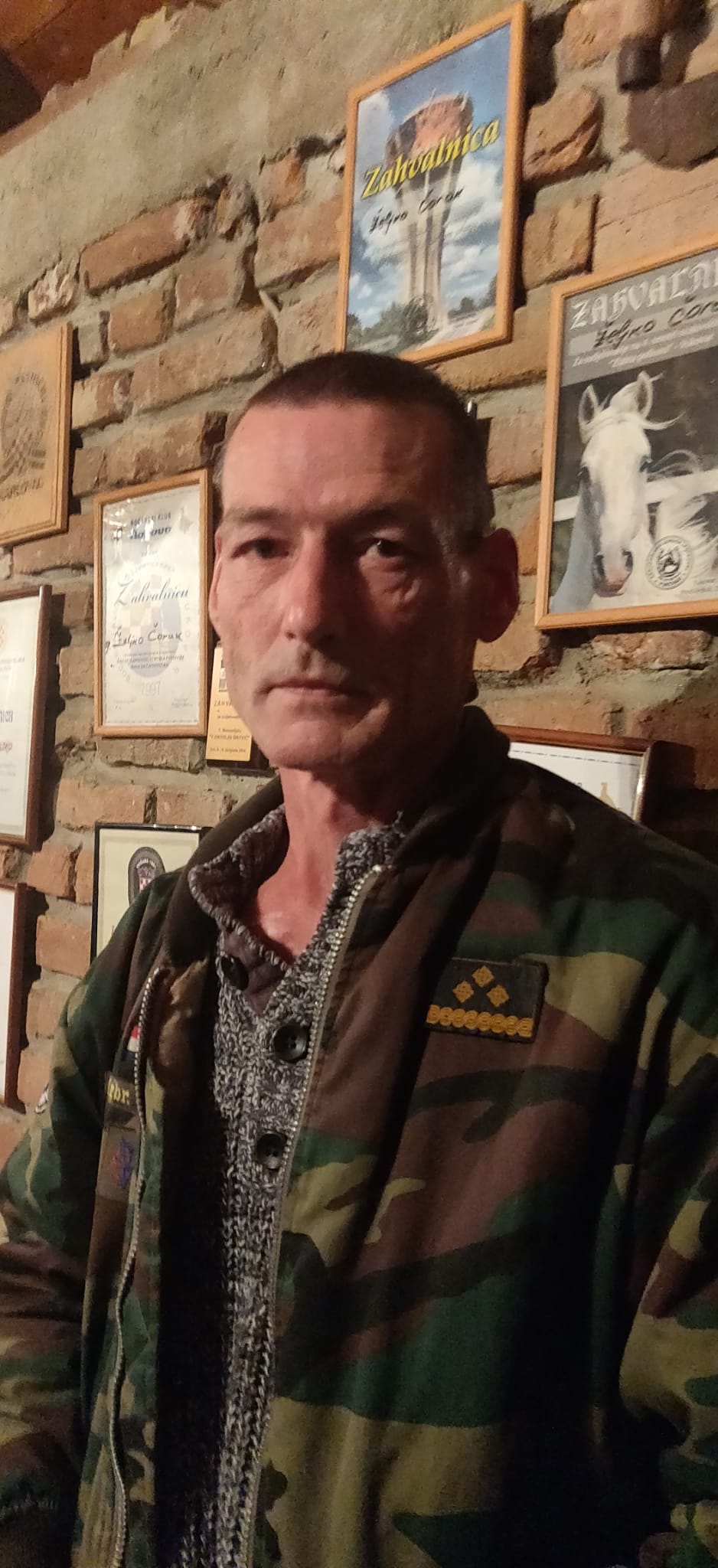
Raymond van der Linden- a Dutch volunteer who defended the city of Lika and went on to continue fighting in the Croatian Homeland War (Photo: Mate Paškanović Pavković)
Amongst the defenders of the city of Vukovar were volunteers from around Europe including those from England, France, and the Netherlands. At a party that is held yearly for the Defenders of the city in Borovo Naselje, a northern neighborhood of Vukovar, I met Raymond van der Linden, a volunteer who came to Lika after watching the events unfold on television in the Netherlands. He went on to talk about the 32 other Dutch volunteers who came to fight in Croatia. Two Dutch volunteers were part of the Dutch Elite forces, the Korps Commandotroepen, and were killed in action in Lika. Raymond would fight in other battles across Croatia including in Gospić. He now lives in Croatia and is happily married to his wife who also served in the Croatian army.
Amongst the missing is the French volunteer defender Jean-Michel Nicolier. Like van der Linden, after watching the events in Vukovar unfold on television, Nicolier said to his mother Lyliane Fournier the following: “I want to help these people, they need me. I must go, but I’ll be back. You know that I’m wild grass that never goes away. “Before the fall of the city, he was severely injured and was brought to the Vukovar Hospital. According to eyewitness accounts, Serb Paramilitary officers transported Nicolier to the Ovčara farm in which officers beat him and shot him in the head.
For the people that came to Croatia to defend the city of Vukovar and other cities, it was about defending freedom and Croatia’s self-determination as a nation. People like van der Linden and Jean-Michel Nicolier came to Croatia because they saw injustice. Their actions are to be honored and they are an example of why Vukovar was not just an ethnic conflict but a moral one.
How do we preserve the legacy of how Vukovar is remembered?
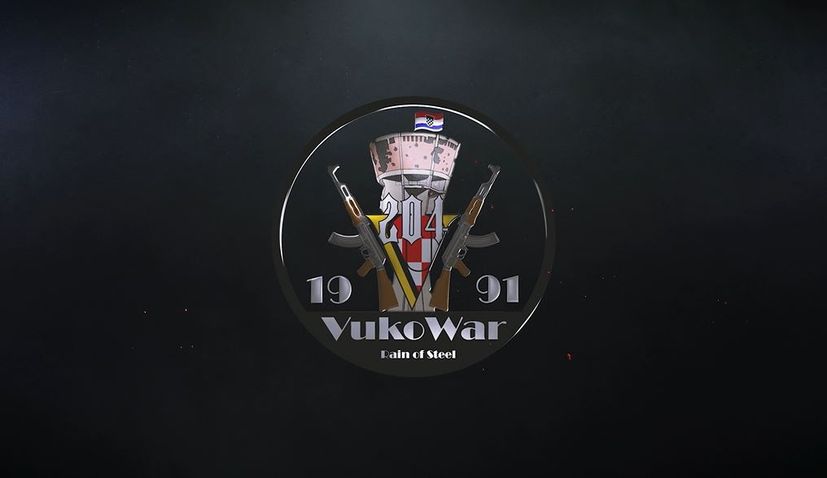
(Vuko War)
On Monday November 15th, 2021, young Croatian programmers presented to the city of Vukovar plans to produce the first ever video game about the heroic actions of the Defenders of Vukovar, VukoWar- Rain of Steel. The video game will be free to download, the storyline will be in English, and it will be based on the real events leading up to the fall of Vukovar, emphasizing an antiwar stance. With other Croatian non-profits, my non-profit, Crodiaspora will be supporting this initiative.
In the past 30 years, the way in which we live has significantly changed. The rise of the internet and its capabilities in retrieving and presenting information has changed the way in which we learn. Video games, for example, are a medium in which people learn about some of the greatest battles in world history. This is what lead two programmers from Slavonski Brod to start producing a video game about Vukovar, Known among Croatians as the Croatian Alamo.
The idea for the video game came about when Darko Galić and Matijas Župan, programmers from Slavonski Brod, started down the ambitious path to create the first ever video game about the Croatian Homeland War. In 2020, they briefly halted development of the game due to lack of funding. Renown author and Vukovar Defender, Damir Plavšić, heard about Galić’s and Župan’s game and soon after spearheaded a campaign that would gather dozens of Croats from around the world to voluntarily start 3D modeling objects in the game. Realizing the importance of this project, Galić, Župan, and Plavšić established Cro Game Devs, a non-profit organization which will develop the game.
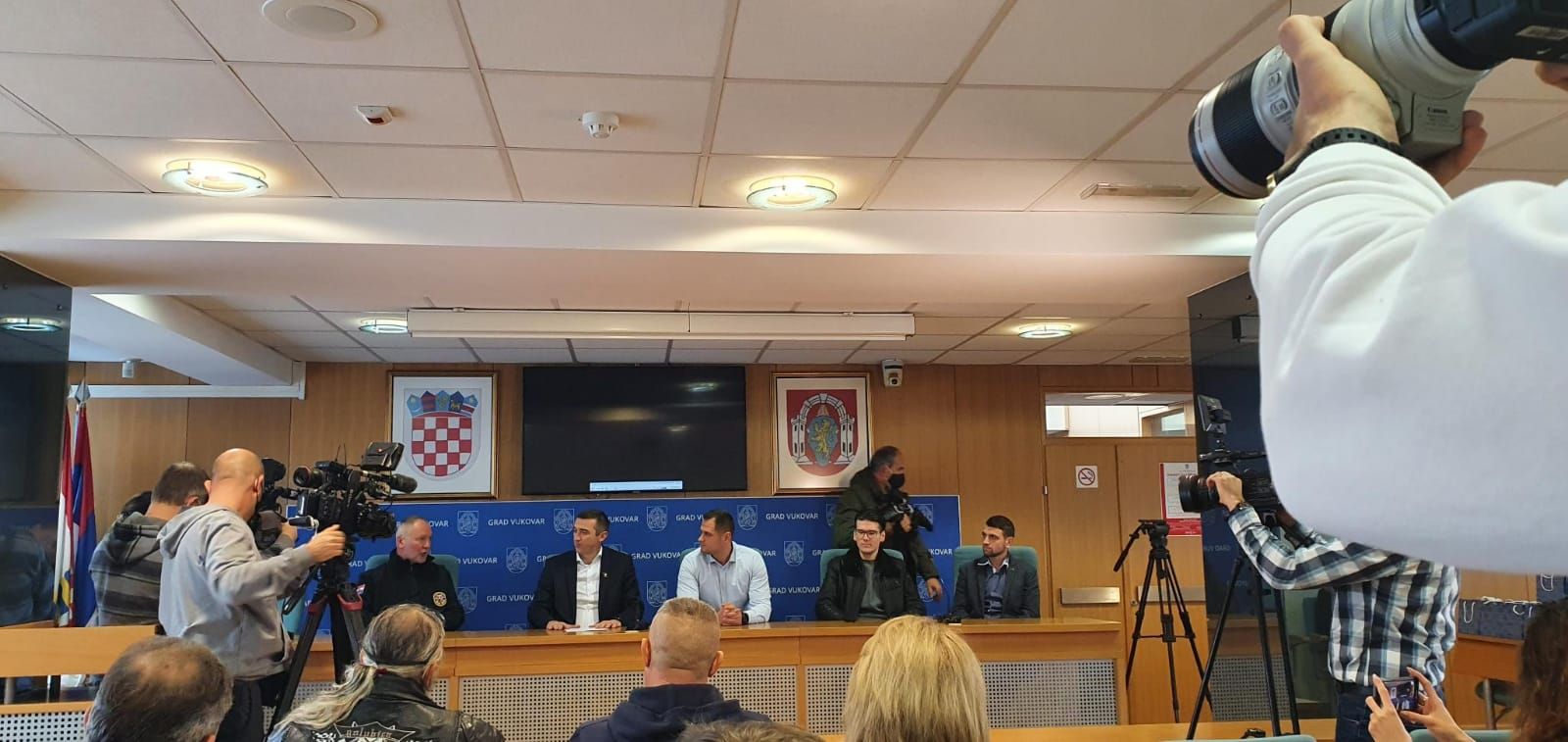
Programmers present VukoWar- Rain of Steel to Mayor of Vukovar Ivan Penava
Member of the Development team, Stjepan Dasović, in his presentation to Vukovar Mayor Ivan Penava, highlighted how VukoWar- Rain of Steel will help unite Croats everywhere:
“The most important aspect of this project is to unify Croats from around the world in producing a common vision and protecting the truth about the Homeland war. We will together strive to create a product which will serve in promoting the Republic of Croatia, Croatian ingenuity, and above all else perpetuate the truth about Croatian history. We want to acquaint the new generation of Croats, as well as youth around the world, born after the Homeland War about the tumultuous path in creating a Democratic and free Croatia.“
As presented in the unofficial results of this year’s Census, Croatia is still facing issues with people emigrating from the country. Cro Game Devs plans to hire 10 programmers with respectable paychecks as well as engage with diaspora in producing the game. As Damir Plavšić highlighted at the press conference in the Vukovar town hall after the presentation:
“War games are a well-established genre in the video game industry, and they are particularly popular in the United States. The First and Second World Wars have been for a long time recreated in video games. The battle has been studied in many military academies around the world. They call it the Croatian Alamo for a reason. Despite losing the battle of Vukovar those who fought until the last hour for Vukovar and escaped, continued to fight for their homeland on other fronts. This opens the door to allow VukoWar- Rain of Steel to have an epilogue and eventually become a video game series that portrays all the battles that lead to Croatia’s victory in the war.”
Conclusion
It has been 30 years since the Vukovar Tragedy. Year after year, on November 18, the Croat authorities bow their heads in genuine remembrance, respect, and piety, however, more needs to be done for the healing to be complete. One thing that needs to be done is to make the world aware of the events that happened so that we do not repeat the horrors of the past. For those who do not have justice for their families, we need to do more for justice to happen. Currently, there is a lawsuit filed in Serbia against the Republic of Serbia for the concentration camps and crimes against humanity that happened within them. Like in many of the other examples in this article, it takes a lot of time to see any glimpse of justice.
In discussions with Dragutin Guzovski, the representative claimant of the lawsuit raised against the Republic of Serbia for the victims of Serbian concentration camps, he said that the lawsuit has been in system for 3.5 years and it will most likely take an additional 3.5 years for them to appeal to the European Court of Human Rights in Strasbourg. The justice for many in Vukovar means that they will have to wait for the judicial system to process their cases. For the victims it has been hard to face the challenges of knowing the cost of a free Croatia, especially those whose family paid the ultimate price for Croatia’s freedom.
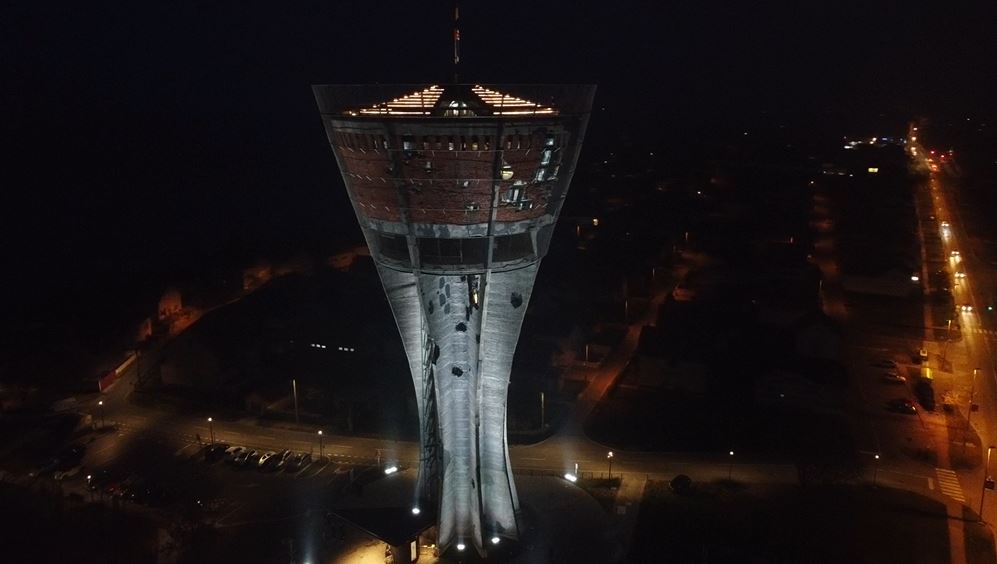
Vukovar Water tower lit up at night. After 29 years, the Water Tower was renovated and opened to the public as a museum and lookout point of the city. It is a symbol of Croatian unity and survival
This article is dedicated to all those who fought for our Homeland and those around the world who helped in any way to establish our Homeland Croatia.
Bože čuvaj našu domovinu Hrvatsku. U nadi je spas.

